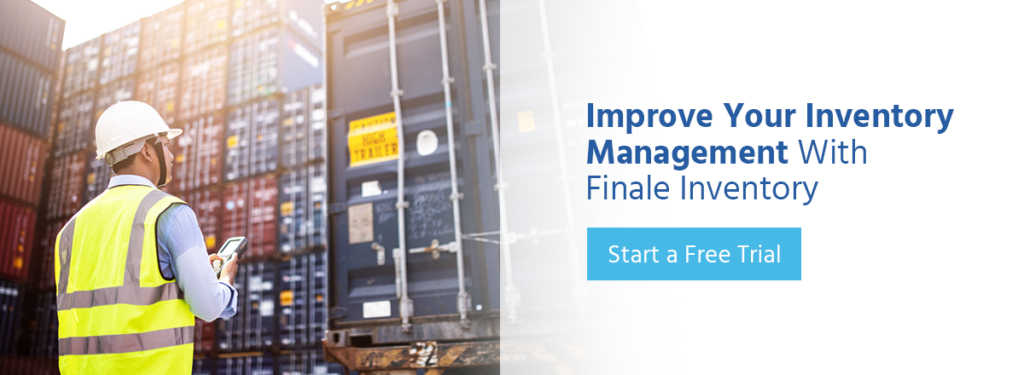So, you’ve found a great price on a shipment of products or materials from an overseas supplier, and you’re excited to take advantage of the deal. Before you make the purchase, take another look at what it will cost to get the products from the supplier to you. Are you seeing the whole picture?
The price of the goods is only one factor that will affect how much you pay to receive them. You’ll have lots of other costs too, especially with overseas shipments. To get an accurate picture of the costs of your shipment, you’ll need to calculate its landed cost.
- What is Landed Cost?
- Why Is Landed Cost Analysis Important?
- How to Calculate Landed Cost
- What Is Included in Total Landed Cost?
- Tips for Calculating Landed Costs
- Landed Cost Calculation Example
- How to Use Finale Inventory to Calculate Landed Costs
- Improve Your Inventory Management With Finale Inventory
What is Landed Cost?
The definition of landed cost, also called landed price, is the total cost to you of getting a product from the supplier to its destination.
To determine this cost, you need to consider the cost of the products themselves, plus any other costs you directly incur to obtain the products. These costs can include everything from shipping to freight costs.
They will also likely include other expenses, especially if you’re importing goods, such as costs associated with customs, duties, insurance, storage and taxes. To calculate the landed cost, you’ll need to add up all of these extra fees and expenses.
You can also calculate the landed cost per unit, which is the total cost for each individual unit, rather than for the entire shipment. You can define units in various ways, including by individual products, by weight or by volume. This number can tell you how much it cost you to ship each product or each portion of your shipment.
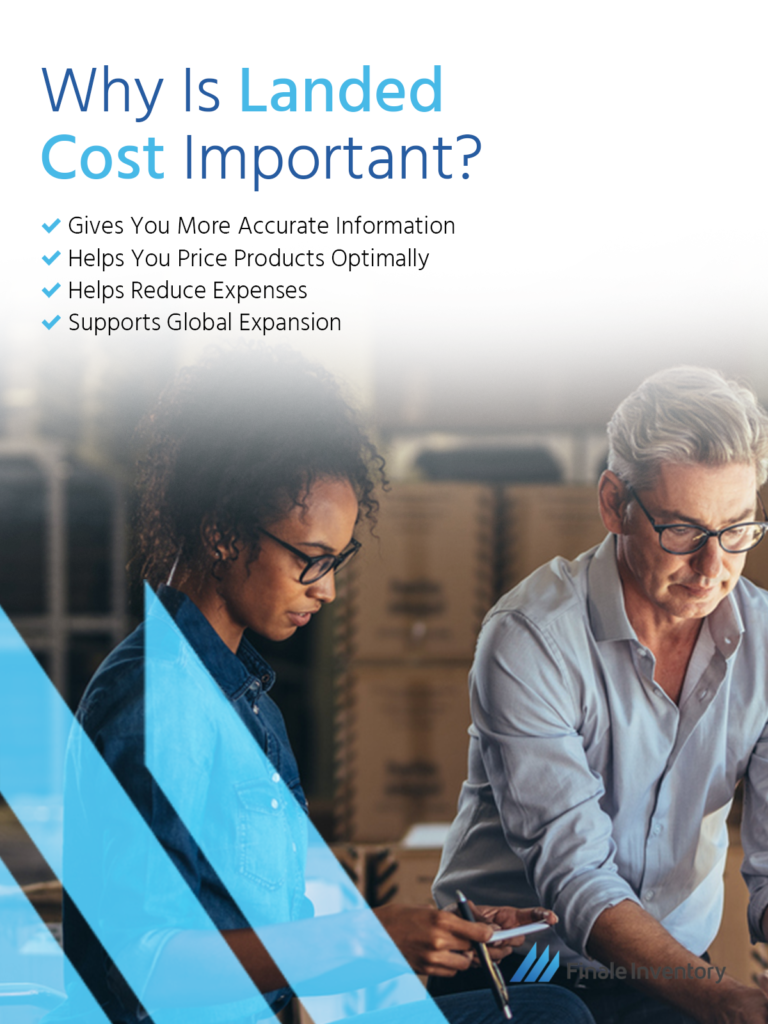
Why Is Landed Cost Analysis Important?
It’s crucial to conduct a landed cost analysis for all your shipments. It gives you a full picture of your costs and helps you make better-informed decisions. Calculating the landed cost is important because it:
Gives You More Accurate Information
There are obvious costs associated with shipments, such as the cost of the goods, but there may also be expenses that are less apparent, such as duties, insurance costs and quality control costs. Calculating the landed cost gives you a complete picture and helps you avoid unexpected expenses, making your reporting and budgeting more accurate.
Helps You Price Products Optimally
If you set your prices too high, you may see a decrease in sales. If you set them too low, your profits may not be as high as you’d like and you may even lose money. Without an accurate idea of how much it costs to ship each product, it’s much harder to price your products at the optimal level.
Understanding landed cost is crucial for knowing how to price imported products. It also gives your sales team an idea of how much they can discount a product while still bringing in a profit.
Helps Reduce Expenses
When it comes to international shipping, the lowest-priced products are not always the best deal because several other factors go into the shipping process. Calculating landed costs requires you to look at all of your expenses related to shipping products. This may reveal opportunities for reducing your costs. Consider whether all of your current costs are worthwhile, whether more cost-effective shipping methods might exist or whether other shippers offer better prices. Analyzing your landed costs can also give you the information you need to negotiate better rates.
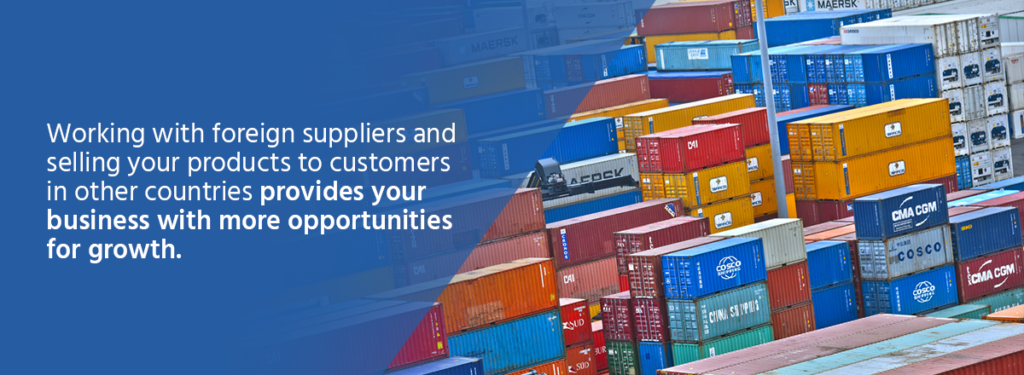
Supports Global Expansion
About 87 percent of U.S. businesses believe international expansion is necessary for long-term growth. Working with foreign suppliers and selling your products to customers in other countries provides your business with more opportunities for growth. You can introduce your brand to new markets and potentially lower your costs.
However, to take advantage of these possibilities, you need to know how much it will cost to expand your operations and partnerships to other countries. Landed cost analysis gives you the information you need to be confident that you can grow your business by expanding internationally.
How to Calculate Landed Cost
To calculate estimated landed costs, you need to add up all of the direct costs involved in getting the products you purchased to you. To determine the total landed cost of a shipment, add up all of the expenses for that shipment.
To work out landed cost price per unit, divide the total landed cost by the number of units in the shipment. Add up all of the costs directly incurred in obtaining the goods and then determine how much of each expense to assign to each unit.
For example, you may pay insurance on an entire shipment. To calculate the cost per unit for insurance, you’ll divide the total cost of insurance for the shipment by the number of units in that shipment.
You can define units in various ways, such as by weight or volume, or each individual product can be a unit. If every item within a shipment is the same, it may make sense to define a unit as a single product. If there are numerous types of products in a shipment, it may be easier to use weight or volume.
You might also want to use the same method that was used to determine costs. For example, if your freight costs are charged by weight, you might want to use weight to determine your landed price per unit.
If different products in the shipment have different costs, you’ll have to consider those differing costs individually. If you purchased insurance for a specific product, that product will have a higher per-unit landed cost. The costs you need to consider will differ from shipment to shipment. Come up with as comprehensive a list of expenses as possible to ensure a calculation is as accurate as possible.
Your supplier should provide you with a quote that contains information you can use in your calculations, including the product details and pricing, the ports being used, the currencies being used, the shipment type and more. It should also include the Harmonized System (HS) codes for the products in question, which determine the tariffs that apply to the products.
Under most agreements, the consignee, or buyer, is responsible for costs incurred after the goods are loaded onto the vessel. However, you should check your agreement carefully to verify who is responsible for which costs. Also, the quote may not include all the costs you will incur, so be sure to take some time to consider all of the expenses carefully.
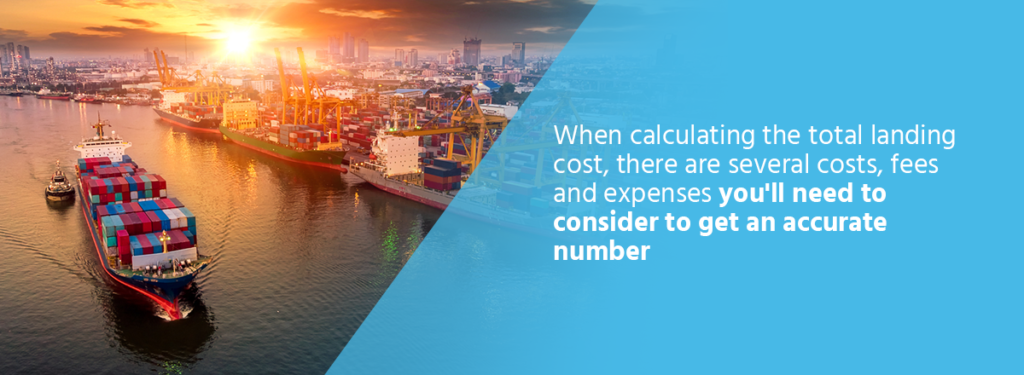
What Is Included in Total Landed Cost?
When calculating the total landing cost, there are several costs, fees and expenses you’ll need to consider to get an accurate number — for example:
The Cost of the Products
The most obvious expense is the cost of the products themselves. Start your calculations with the price per unit you need to pay the supplier to obtain the items. The commercial invoice, which you will need for the international shipping process, will give you the price.
Freight and Shipping Costs
Another fairly apparent cost is freight or shipping. While obvious, these costs can sometimes be tricky to calculate since they may include several charges and vary based on the shipping methods you’re using. If you use multiple shippers in various areas, you need to add the costs of all of these shippers’ services.
Shipping and freight costs may include costs for transportation, packing, crating and handling. For international air or sea freight, a freight forwarder will quote you a price that typically includes charges for an international shipping fee, handling charges at port and transport from the port to the shipment’s final destination.
Customs Costs
When importing or exporting products, you need to consider customs in your cost calculations. If you purchase items from a supplier in a foreign country, you’ll need to pay import fees. If you sell goods to customers in foreign countries, you’ll need to pay export fees.
Expenses related to customs may include duties, tariffs, levies, taxes, value-added tax, harbor fees, brokerage fees and more. To avoid delays and the resulting higher costs when attempting to clear customs, make sure your commercial invoice includes all of the necessary information.
Governments charge customs duties on imported goods. The amount you have to pay is typically a percentage of the cost of the goods or the combined cost of the goods, freight and insurance, which typically depends on the country and the product being imported. These costs can vary substantially and may be a significant expense, so it’s essential to account for them.
Customs authorities and brokers may also charge customs processing fees. Customs authorities ensure that all shipments comply with the relevant laws and regulations, and customs brokers organize and file customs clearances. Other duties you may need to pay, depending on the shipment, include anti-dumping and countervailing duties.
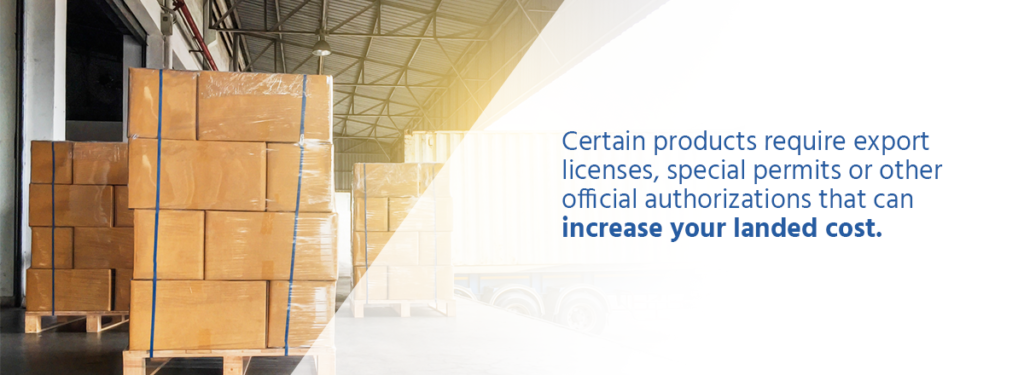
Export licenses
Certain products require export licenses, special permits or other official authorizations that can increase your landed cost. These requirements vary by country and product type, so be sure to conduct thorough research about whether you need any special authorizations. Also, apply for any licenses you need as early as possible to avoid extra costs and complications.
Taxes
Like with almost all other transactions, you need to consider taxes, as they can make up a significant portion of your landed cost. Tax policies in some countries are more favorable than in others, so you may be able to save money by importing from or exporting to different countries. With some research, you may also be able to find tax breaks.
Risk-Related Costs
You may also have various costs related to mitigating risk. These costs include anything you pay to protect your products, business or customers. They typically include costs related to insurance, compliance and quality assurance.
Freight forwarders often offer insurance on the goods they ship, but you can also purchase insurance from third parties. Insurance should cover the entire cost of shipping your products, not just the cost of the products themselves.
Your compliance costs might include working with a third party that specializes in compliance, the costs of required documentation and other expenses. You may also pay employees to conduct quality assurance work or purchase technologies to help with quality assurance.
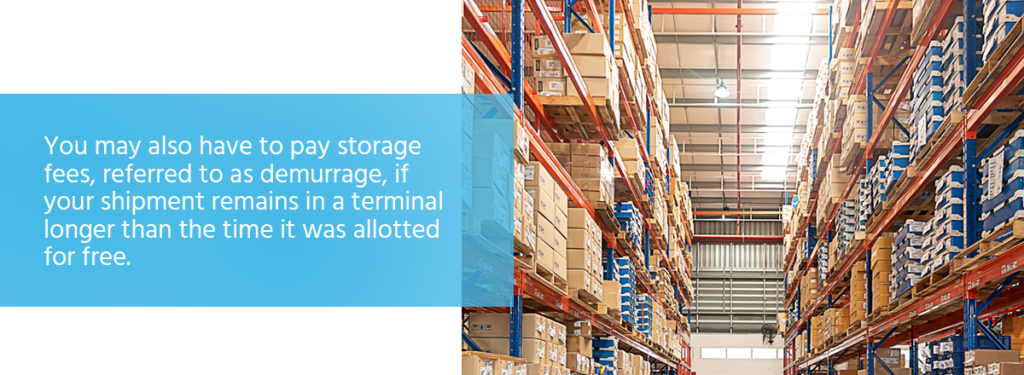
Storage Fees
You may also have to pay storage fees, referred to as demurrage, if your shipment remains in a terminal longer than the time it was allotted for free. Your shipment might surpass the free storage limit if it has to wait longer than expected for transportation, unloading or to clear customs. You can avoid these fees by planning your shipment carefully to prevent delays, but many shippers face this situation occasionally, so you should be aware that these fees exist.
Other Overhead Costs
Some other overhead costs you may need to account for include paying for currency conversion, payment processing fees, bank charges and purchasing agency commissions.
Tips for Calculating Landed Costs
There’s a lot to consider when shipping goods internationally and calculating landed price. Some tips to keep in mind are:
1. Don’t Forget About Exchange Rates
When shipping internationally, you’re likely dealing with multiple currencies. To get an accurate idea of your costs, you need to consider the current exchange rates for all of the currencies used in the documents you receive. Use the exchange rate on the date you receive the goods to get the most accurate numbers and remember the exchange rate you get is usually less than the trading value.
2. You May Need to Estimate
Sometimes, you may not know the exact costs of something until after your shipment arrives. In these cases, you need to estimate your costs as accurately as possible. Get estimates from the companies you work with and look at costs from previous shipments to get an idea of how much you’ll have to pay.
While you should determine as many of your costs in advance as possible, an informed estimate can go a long way. Then, once you get your actual, final costs, reconcile them against the estimates you used.
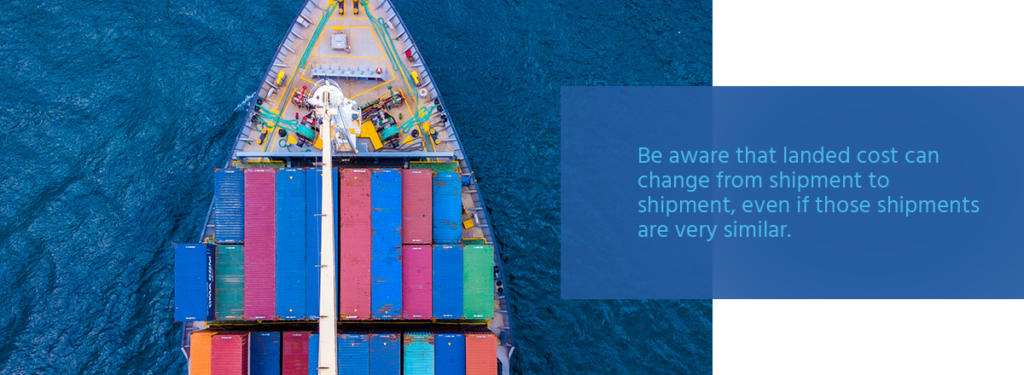
3. Landed Cost Can Vary Between Shipments
Be aware that landed cost can change from shipment to shipment, even if those shipments are very similar. For the most accurate numbers, you’ll need to calculate the landed cost for each shipment, or at least calculate it periodically. Even if two shipments contain the same goods, use the same methods and freight forwarders, and are identical in almost every other way, the landed price may differ, especially if they are shipped at two different times.
Freight rates vary throughout the year, and fees, duties, taxes, exchange rates and other factors can change relatively quickly. One shipment might also be subject to demurrage while another isn’t, potentially due to circumstances outside of your control.
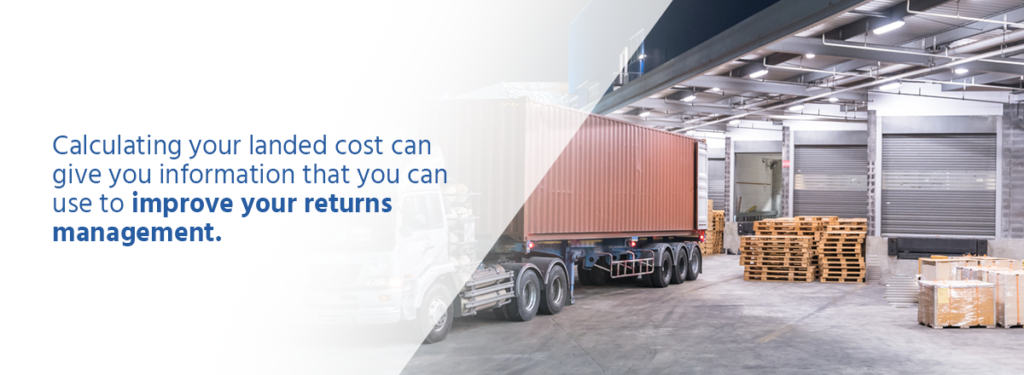
4. Consider Returns Management
Calculating your landed cost can give you information that you can use to improve your returns management. When returning goods to international customers, you’ll need to consider what to do about costs related to shipping, duties, taxes and other factors. You may ask customers to pay to recoup some of these costs.
If you offer free shipping, considering all of these costs will give you a more accurate idea of how much free returns will cost your company. Which return policies are right for your company and customers will depend on the types of products you offer, how you ship your products and other factors. Looking at your landed cost can help you determine which policy is the right choice.
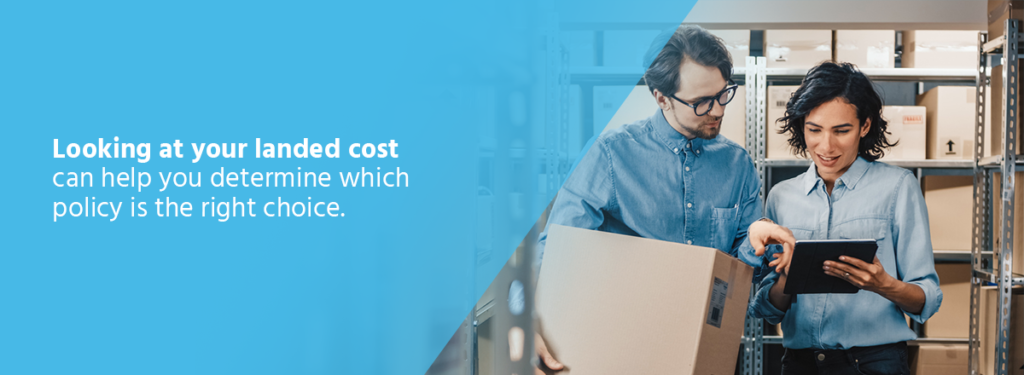
Landed Cost Calculation Example
To understand how to work out landed cost, consider the following example:
Let’s say, for example, you run a clothing company that’s based in the United States, and you purchase 500 pairs of shoes from a supplier in another country. The shoes cost you $50 per unit, which comes to a total of $25,000. The duty is two percent, the freight for the shipment costs $800, and insurance costs $500. An import tax of 10 percent is charged on the final value of the imported goods.
There would likely be other factors to consider as well, but for the sake of simplicity, we’ll limit the calculations to these factors in this example.
Before you calculate your landed costs, you should ensure all currencies are converted to your local currency — in this case, the United States dollar (USD). Remember to take into account the exchange rates you’ll receive. Then, you can add up your costs.
- Total product costs: 500 units times $50 equals $25,000
- Freight: $800
- Customs: $25,000 times two percent equals $500
- Insurance: $500
- Tax: $25,000 times 10 percent equals $2,500
Based on these numbers, your total landed cost would be $29,300.
To calculate the landed cost per unit — if you define a unit as one pair of shoes — you would divide $29,300 by 500, which is the number of units you shipped. That comes out to $58.60 per unit. You now know that it costs you $58.60 to ship each pair of shoes to your warehouse and $29,300 to ship one shipment of 500 pairs. You can use that information to set prices, make future shipping decisions and more.
How to Use Finale Inventory to Calculate Landed Costs
Manually calculating landed costs can be tedious, especially for large shipments with many different SKUs. Using technology can help you make your calculations much more efficiently and, often, more accurately.
Finale Inventory includes a feature that can help you to manage landed cost. It can assist you in allocating costs as you add items to your inventory after receiving a purchase order shipment. Here’s how to calculate product cost using the feature:
With Finale Inventory, you can allocate your costs using four different methods:
- Order item quantity
- Order item weight
- Order item subtotal
- Order item cubic meters (CBM)
To use the CBM method, you need to go into “Application Settings” and enable the CBM fields. The product IDs also must have a per-unit CBM value.
To set up landed cost or cost allocation, take the following steps:
- Go to “Application Settings” and select the “Purchasing” tab.
- Select “Discounts and Fees.”
- Create a cost/fee name for the charges you will incur on your purchase order.
- Choose an allocation method.
- Use the costs/fees you created to collect costs for your purchase order.
Once you have completed this for your entire purchase order, you can view your landed cost by doing the following:
- Go to the “Purchase order detail” screen.
- Go to the “Actions” menu.
- Choose “Customize this screen” in the menu.
- Scroll to the bottom of the list in “Customize this screen”.
- Check the box.
- Save your changes.
- Use the back button to go back to the “Purchase order detail” screen.
Improve Your Inventory Management With Finale Inventory
At Finale Inventory, our experts partner with you to create a solution that meets the unique needs of your business, and we’ll work with you to provide the consulting, training and customization you require.
Our sophisticated multichannel inventory management software includes a tool for calculating landed cost as well as a variety of other features, such as inventory control, order management and serial number tracking. It also easily integrates with a variety of other platforms, including accounting software, point-of-sale systems and more.
To learn more about Finale Inventory, start your free trial or schedule a demo today.




